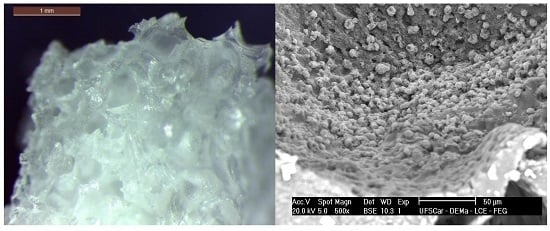Bioactive Glass Fiber-Reinforced PGS Matrix Composites for Cartilage Regeneration
Abstract
:1. Introduction
2. Results
2.1. Biocomposite Structure
2.2. Degradation Tests
2.3. Bioactivity Tests
2.4. Mechanical Properties
3. Discussion
4. Materials and Methods
4.1. Glass Fiber Manufacture
4.2. Fabrication of the PGS-Reinforced Scaffolds
4.3. Characterization of the Biocomposites
4.3.1. Biocomposite Morphology
4.3.2. Degradation Tests
4.3.3. Bioactivity Tests
4.3.4. Mechanical Properties
5. Conclusions
Acknowledgments
Author Contributions
Conflicts of Interest
References
- Ravindran, S.; Kotecha, M.; Huang, C.; Ye, A.; Pothirajan, P.; Yin, Z.; Magin, R.; George, A. Biological and MRI characterization of biomimetic ECM scaffolds for cartilage tissue regeneration. Biomaterials 2015, 71, 58–70. [Google Scholar] [CrossRef] [PubMed]
- Mow, V.; Ratcliffe, A.; Poole, A. Cartilage and diarthrodial joints as paradigms for hierarchical materials and structures. Biomaterials 1992, 13, 67–97. [Google Scholar] [CrossRef]
- Rai, R.; Tallawi, M.; Grigore, A.; Boccaccini, A.R. Synthesis, properties and biomedical applications of poly(glycerolsebacate) (PGS): A review. Prog. Polym. Sci. 2012, 37, 1051–1078. [Google Scholar] [CrossRef]
- Wang, Y.; Ameer, G.; Sheppard, B.; Langer, R. A tough biodegradable elastomer. Nat. Biotechnol. 2002, 20, 602–606. [Google Scholar] [CrossRef] [PubMed]
- Chen, Q.Z.; Ishii, H.; Thouas, G.A.; Lyon, A.R.; Wright, J.S.; Blaker, J.J.; Chirzanowski, W.; Boccaccini, A.R.; Ali, N.N.; Knowles, J.C.; et al. An elastomeric patch derived from poly(glycerol sebacate) for delivery of embryonic stem cells to the heart. Biomaterials 2010, 31, 3885–3893. [Google Scholar] [CrossRef] [PubMed]
- Jean, A.; Engelmayr, G.J. Finite element analysis of an accordion-like honeycomb scaffold for cardiac tissue engineering. J. Biomech. 2010, 43, 3035–3043. [Google Scholar] [CrossRef] [PubMed]
- Radisc, M.; Park, H.; Martens, T.P.; Lazaro, J.E.S.; Geng, W.; Wang, Y.; Langer, R.; Freed, L.E.; GV, N. Pre-treatment of synthetic elastomeric scaffold by cardiac fibroblast improves engineered heart tissue. J. Biomed. Mater. Res. A 2008, 86, 713–724. [Google Scholar] [CrossRef]
- Gao, J.; Crapo, P.M.; Wang, Y. Macroporous elastomeric scaffolds with extensive micropores for soft tissue engineering. Tissue Eng. 2006, 12, 917–925. [Google Scholar] [CrossRef] [PubMed]
- Crapo, P.M.; Gao, J.; Wang, Y. Seamless tubular poly(glycerol sebacate) scaffolds: High-yield fabrication and potential applications. J. Biomed. Mater. Res. A 2008, 86, 354–363. [Google Scholar] [CrossRef] [PubMed]
- Kemppainen, J.M.; Hollister, S. Tailoring the mechanical properties of 3D-designed poly(glycerol sebacate) scaffolds for cartilage applications. J. Biomed. Mater. Res. A 2010, 94, 9–18. [Google Scholar] [CrossRef] [PubMed]
- Jeong, C.G.; Hollister, S. A comparison of the influence of material on in vitro cartilage tissue engineering with PCL, PGS, and POC 3D scaffold architecture seeded with chondrocytes. Biomaterials 2010, 31, 4304–4312. [Google Scholar] [CrossRef] [PubMed]
- Sundback, C.A.; Shyu, J.Y.; Wang, Y.; Faquin, W.C.; Langer, R.S.; Vacanti, J.P.; TA, H. Biocompatibility analysis of poly(glycerol sebacate) as a nerve guide material. Biomaterials 2005, 26, 5454–5464. [Google Scholar] [CrossRef] [PubMed]
- Rydevik, B.L.; Kwan, M.K.; Myers, R.R.; Brown, R.A.; Triggs, K.J.; Woo, S.L.; Garfin, S.R. An in vitro mechanical and histological study of acute stretching on rabbit tibial nerve. J. Orthop. Res. 1990, 8, 694–701. [Google Scholar] [CrossRef] [PubMed]
- Pritchard, C.D.; Arnér, K.M.; Neal, R.A.; Neeley, W.L.; Bojo, P.; Bachelder, E.; Holz, J.; Watson, N.; Botchwey, E.A.; Langer, R.S.; et al. The use of surface modified poly(glycerol-co-sebacic acid) in retinal transplantation. Biomaterials 2010, 31, 2153–2162. [Google Scholar] [CrossRef] [PubMed]
- Ghosh, F.; Neeley, W.L.; Arnér, K.; Langer, R. Selective removal of photoreceptor cells in vivo using the biodegradable elastomer poly(glycerol sebacate). Tissue Eng. A 2011, 17, 1675–1682. [Google Scholar] [CrossRef] [PubMed]
- Sundback, C.A.; Mcfadden, J.; Hart, A.; Kulig, K.M.; Wieland, A.M.; Pereira, M.J.; Pomerantseva, I.; Hartnick, C.J.; Masiakos, P. Behavior of poly(glycerol sebacate) plugs in chronic tympanic membrane perforations. J. Biomed. Mater. Res. B Appl. Biomater. 2012, 100, 1943–1954. [Google Scholar] [CrossRef] [PubMed]
- Wieland, A.M.; Sundback, C.A.; Hart, A.; Kulig, K.; Masiakos, P.T.; Hartnick, C. Poly(glycerol sebacate)-engineered plugs to repair chronic tympanic membrane perforations in a chinchilla model. Otolaryngol. Head Neck Surg. 2010, 143, 127–133. [Google Scholar] [CrossRef] [PubMed]
- Liang, S.L.; Cook, W.D.; Thouas, G.A.; Chen, Q. The mechanical characteristics and in vitro biocompatibility of poly(glycerol sebacate)-bioglass elastomeric composites. Biomaterials 2010, 31, 8516–8529. [Google Scholar] [CrossRef] [PubMed]
- Katz, H.S.; Milewski, J. Handbook of Fillers for Plastics; Van Nostrand Reinhold Company: Melbourne, Australia, 1987; Volume 1. [Google Scholar]
- ISO 10993-14. Biological Evaluation of Medical Devices—Part 14: Identification and Quantification of Degradation Products from Ceramics; International Organization for Standardization: Geneva, Switzerland, 2001. [Google Scholar]
- Jones, J.R.; Sepulveda, P.; Hench, L. Dose-dependent behavior of bioactive glass dissolution. J. Biomed. Mater. Res. 2001, 58, 720–726. [Google Scholar] [CrossRef] [PubMed]
- Salehi, S.; Fathi, M.; Javanmard, S.H.; Barneh, F.; Moshayedi, M. Fabrication and characterization of biodegradable polymeric films as a corneal stroma substitute. Adv. Biomed. Res. 2015, 6, 9. [Google Scholar] [CrossRef] [PubMed]
- Leblon, C.E.; Pai, R.; Fodor, C.R.; Golding, A.S.; Coulter, J.P.; Jedlicka, S. In vitro comparative biodegradation analysis of salt-leached porous polymer scaffolds. J. Appl. Polym. Sci. 2013, 128, 2701–2712. [Google Scholar] [CrossRef]
- Sun, Z.J.; Wua, L.; Lu, X.L.; Meng, Z.X.; Zheng, Y.F.; Dong, D. The characterization of mechanical and surface properties of poly(glycerol–sebacate–lactic acid) during degradation in phosphate buffered saline. Appl. Surf. Sci. 2008, 255, 350–352. [Google Scholar] [CrossRef]
- Chen, Q.Z.; Thompson, I.D.; Boccaccini, A.R. 45S5 Bioglass®-derived glass-ceramic scaffolds for bone tissue engineering. Biomaterials 2006, 27, 2414–2425. [Google Scholar] [CrossRef] [PubMed]
- Chen, Q.Z.; Quinn, J.M.W.; Thouas, G.A.; Zhou, X.; Komesaroff, P. Bonelike elastomeric toughened scaffolds with degradability kinetics matching healing rates. Adv. Eng. Mater. 2010, 12, B642–B648. [Google Scholar] [CrossRef]
- Miguez-Pacheco, V.; Hench, L.L.; Boccaccini, A.R. Bioactive glasses beyond bone and teeth: Emerging applications in contact with soft tissue. Acta Biomater. 2015, 13, 1–15. [Google Scholar] [CrossRef] [PubMed]
- Chen, Q.; Jin, L.; Cook, W.D.; Mohn, D.; Lagerqvist, E.L.; Elliott, D.A.; Haynes, J.M.; Boy, N.; Stark, W.J.; Pouton, C.W.; et al. Elastomeric nanocomposites as cell delivery vehicles and cardiac support devices. Soft Matter 2010, 6, 4715–4726. [Google Scholar] [CrossRef]
- Pomerantseva, I.; Krebs, N.; Hart, A.; Neville, C.M.; Huang, A.Y.; Sundback, C. Degradation behavior of poly(glycerol sebacate). J. Biomed. Mater. Res. A 2009, 91, 1038–1047. [Google Scholar] [CrossRef] [PubMed]
- Wang, Y.; Kim, Y.M.; Langer, R. In vivo degradation characteristics of poly(glycerol sebacate). J. Biomed. Mater. Res. A 2003, 66, 192–197. [Google Scholar] [CrossRef] [PubMed]
- Seal, B.L.; Otero, T.C.; Panitch, A. Polymeric biomaterials for tissue and organ regeneration. Mater. Sci. Eng. Rep. 2001, 34, 147–230. [Google Scholar] [CrossRef]
- Nooeaid, P.; Salih, V.; Beier, J.P.; Boccaccini, A.R. Osteochondral tissue engineering: Scaffolds, stem cells and applications. J. Cell. Mol. Med. 2012, 16, 2247–2270. [Google Scholar] [CrossRef] [PubMed]
- Gabbai-Armelin, P.R.; Souza, M.T.; Kido, H.W.; Tim, C.R.; Bossini, P.S.; Fernandes, K.R.; Magri, A.M.; Parizotto, N.A.; Fernandes, K.P.; Mesquita-Ferrari, R.A.; et al. Characterization and biocompatibility of a fibrous glassy scaffold. J. Tissue Eng. Reg. Med. 2015. [Google Scholar] [CrossRef] [PubMed]
- Gabbai-Armelin, P.R.; Souza, M.T.; Kido, H.W.; Tim, C.R.; Bossini, P.S.; Magri, A.M.; Fernandes, K.R.; Pastor, F.A.; Zanotto, E.D.; Parizotto, N.A.; et al. Effect of a new bioactive fibrous glassy scaffold on bone repair. J. Mater. Sci. Mater. Med. 2015, 26, 177. [Google Scholar] [CrossRef] [PubMed]
- Souza, M.T.; Peitl, O.; Zanotto, E.D. Vitreos Composition, Bioactive Vitreous Fibres and Fabrics and Articles. Patent WO 201 502 151 9 A1, 19 February 2015. [Google Scholar]
- Kokubo, T.; Takadama, H. How useful is SBF in predicting in vivo bone bioactivity? Biomaterials 2006, 27, 2907–2915. [Google Scholar] [CrossRef] [PubMed]
- Ghasemi-Mobarakeh, L.; Prabhakaran, M.P.; Morshed, M.; Nasr-Esfahani, M.H.; Ramakrishna, S. Bio-functionalized PCL nanofibrous scaffolds for nerve tissue engineering. Mater. Sci. Eng. C 2010, 30, 1129–1136. [Google Scholar] [CrossRef]
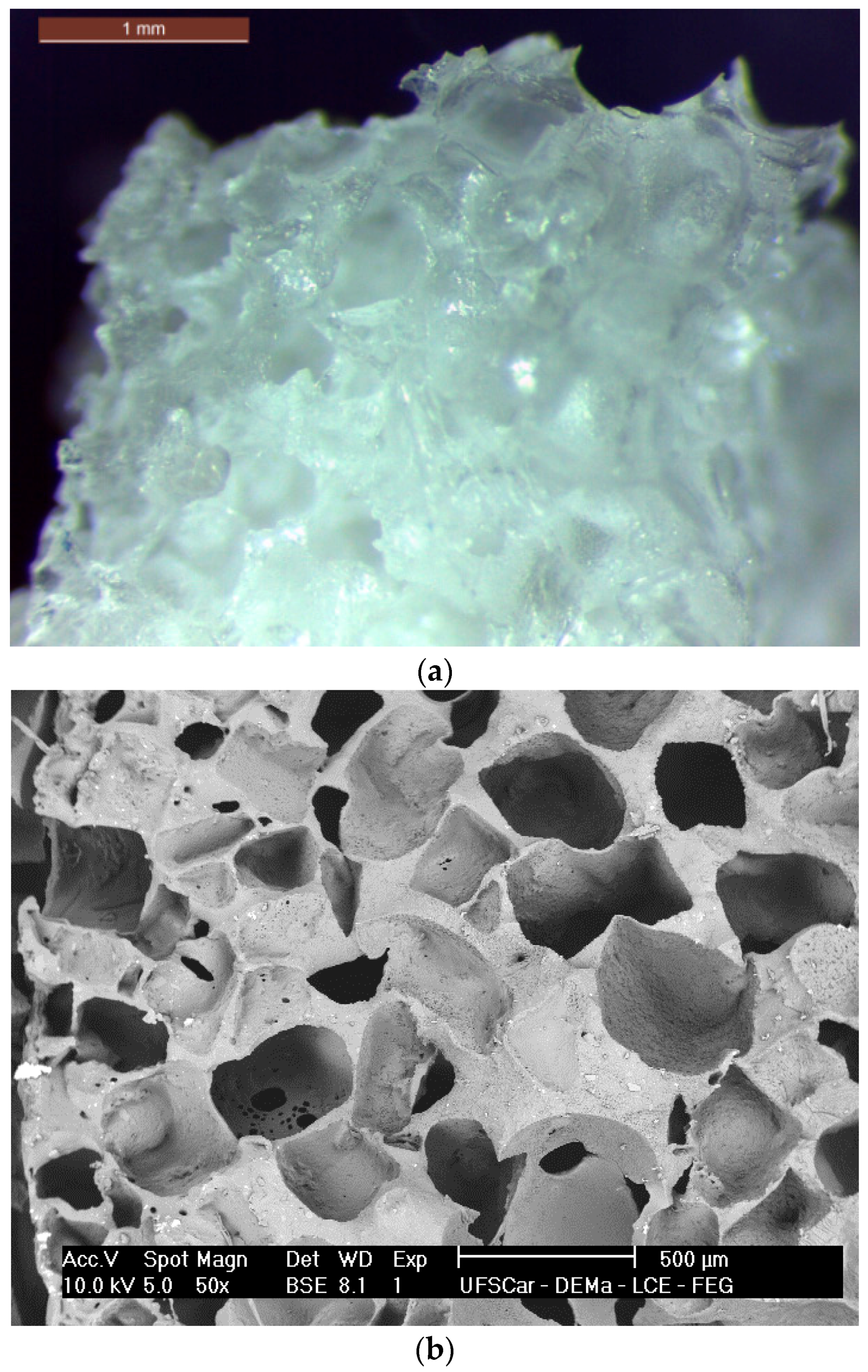
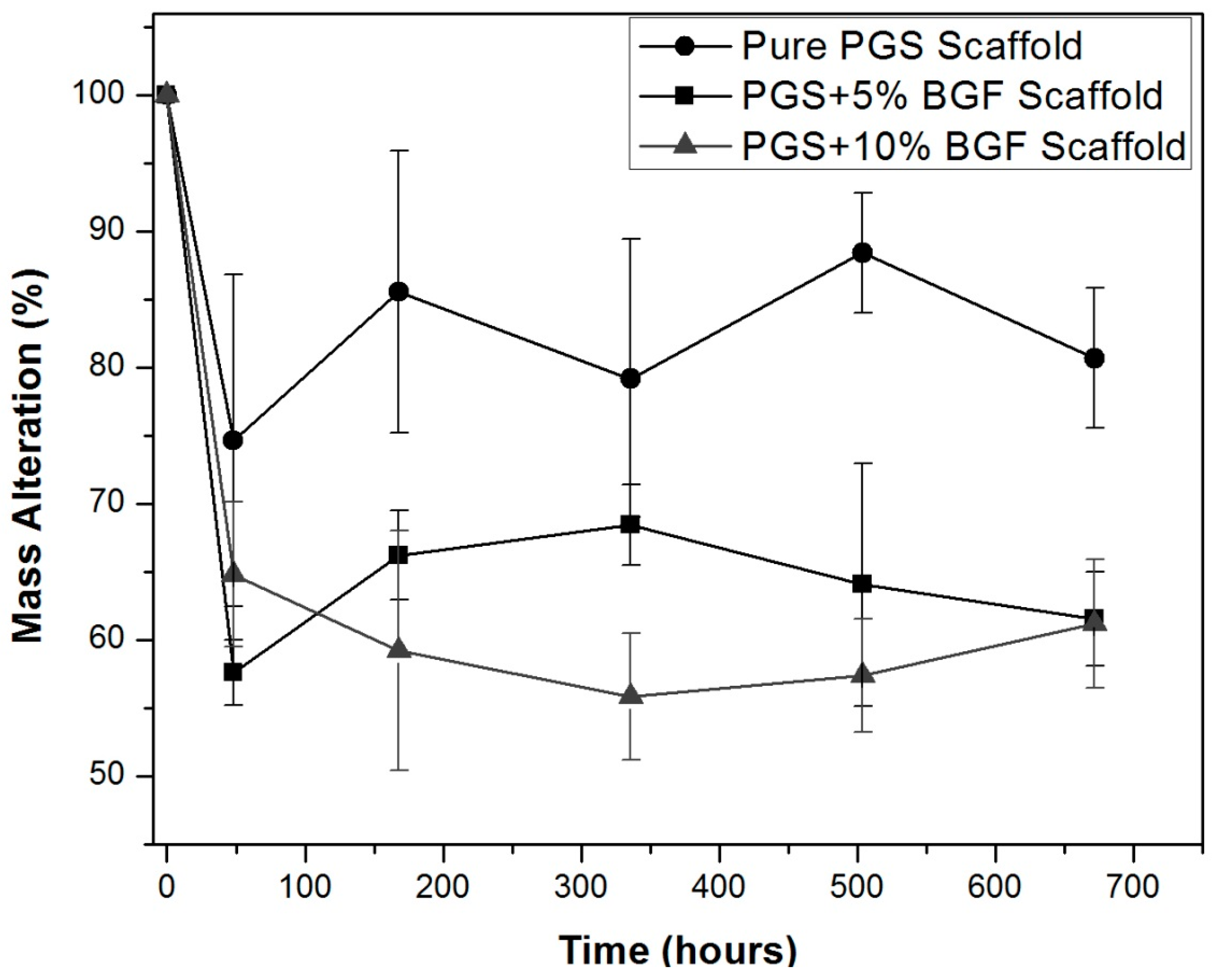
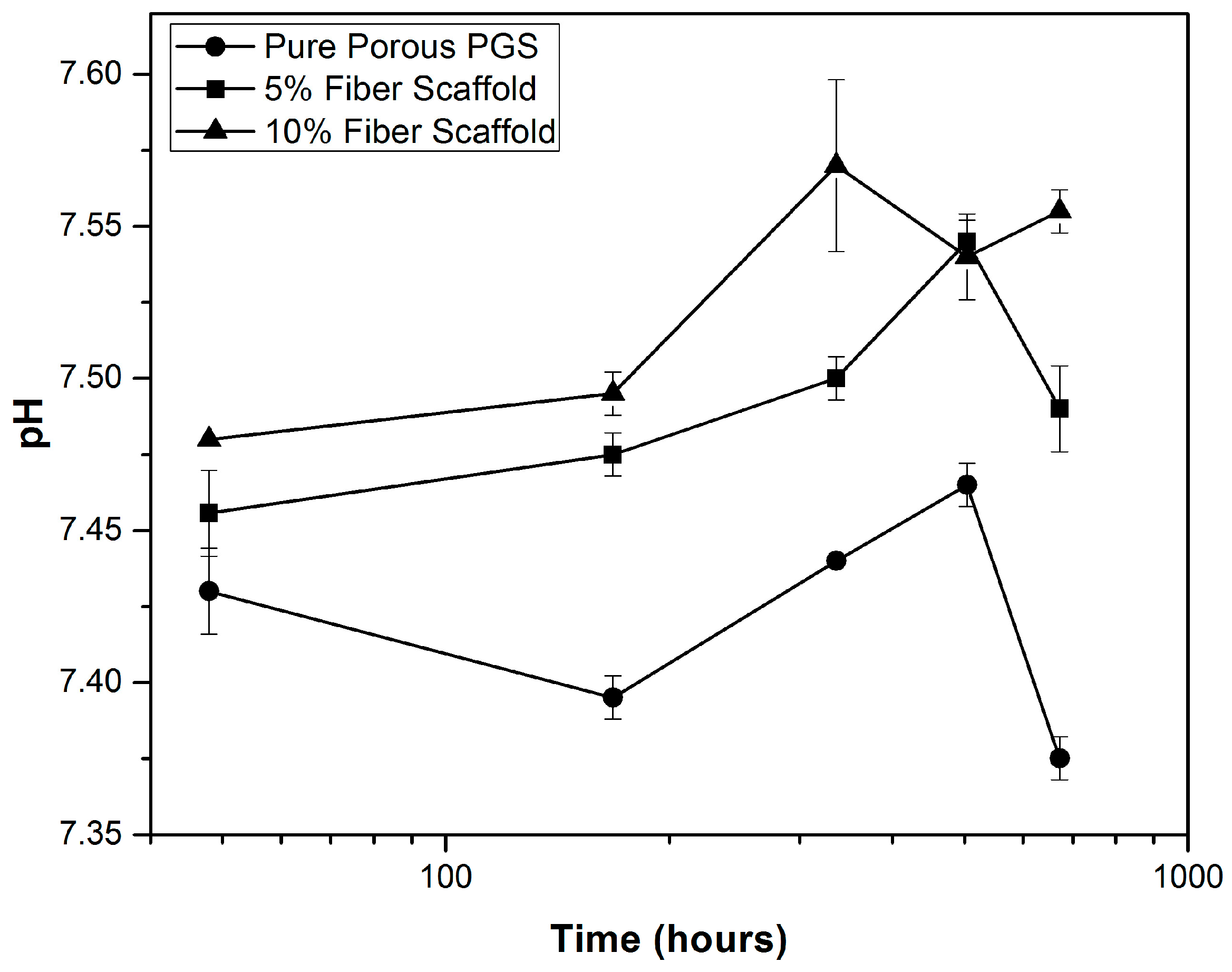
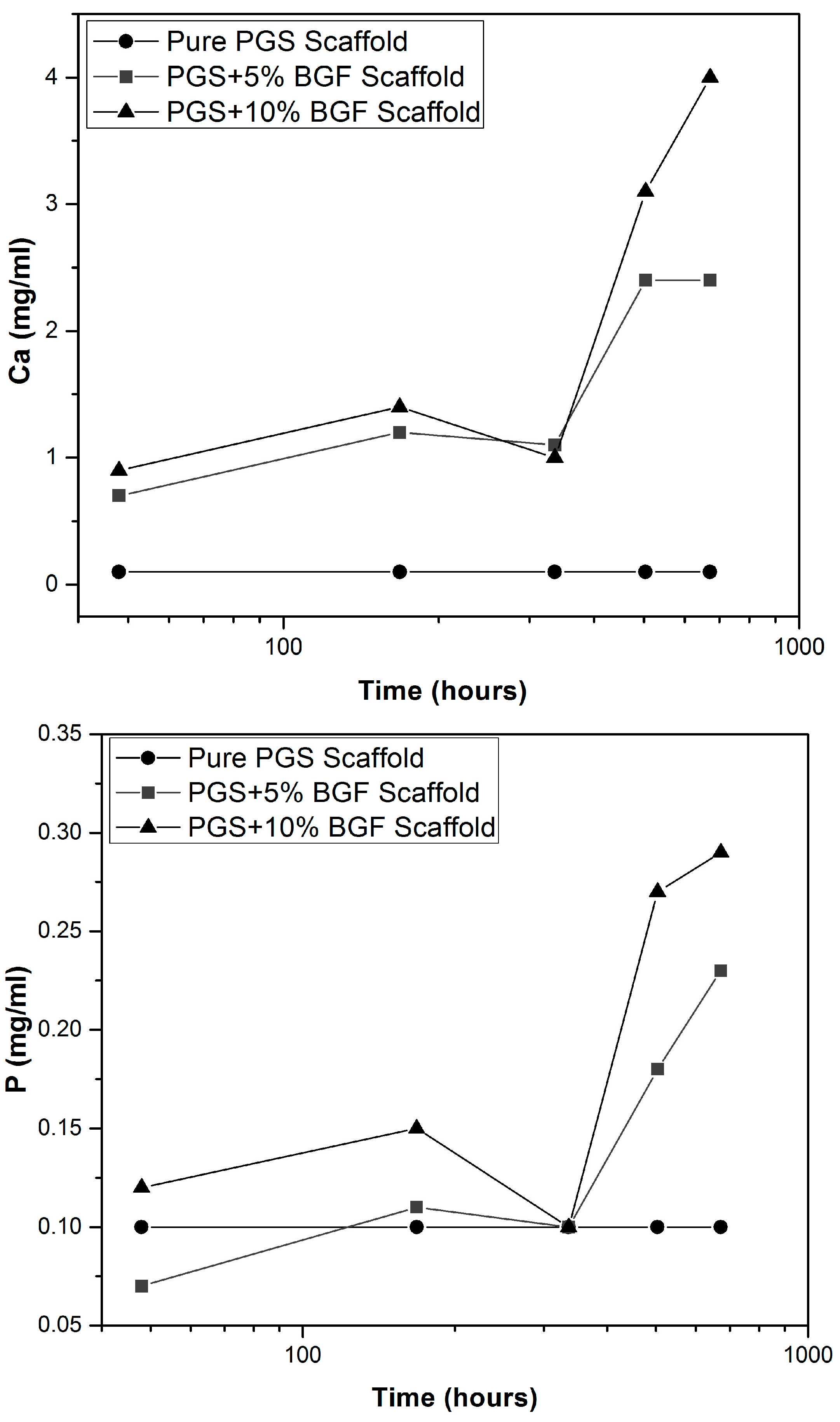
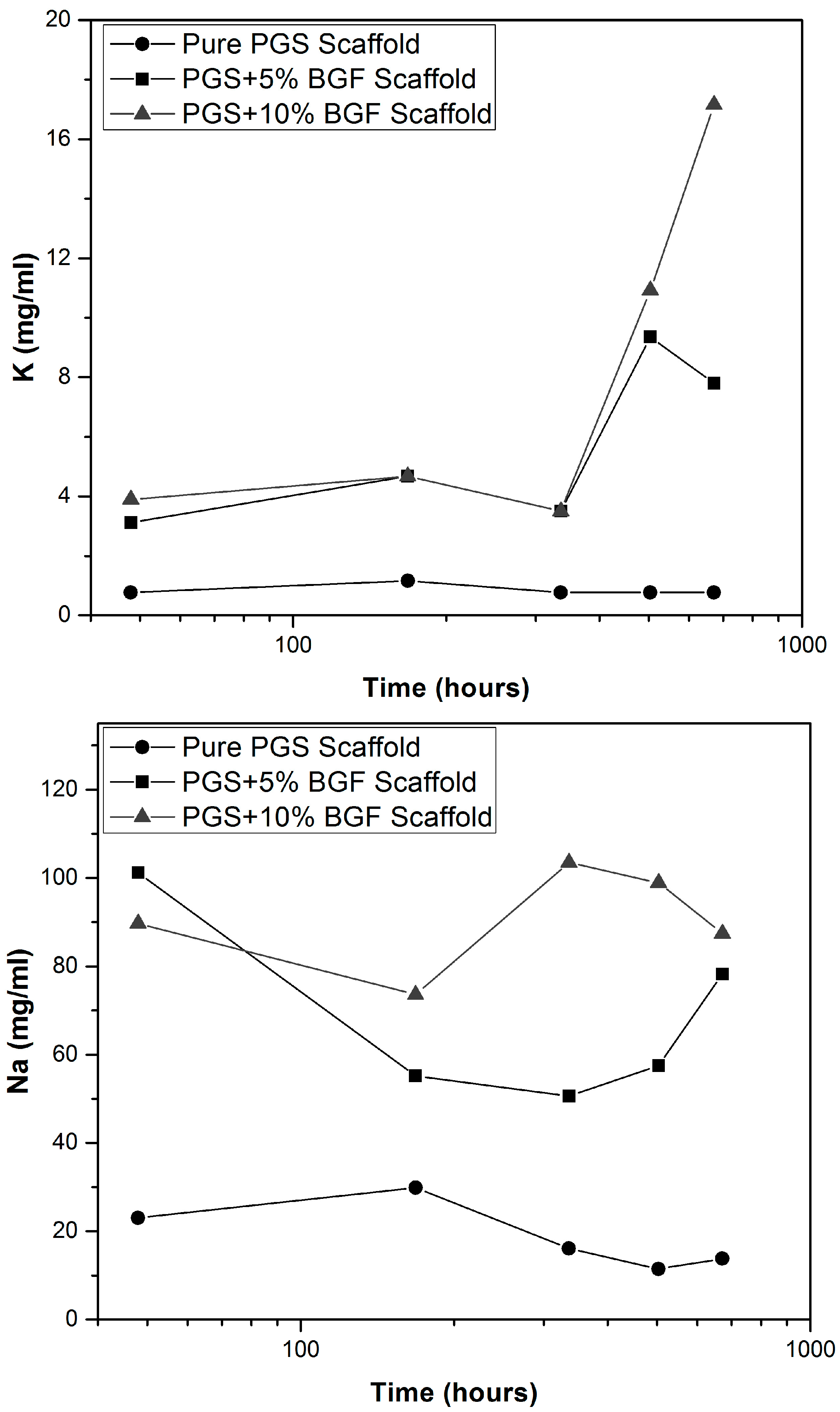
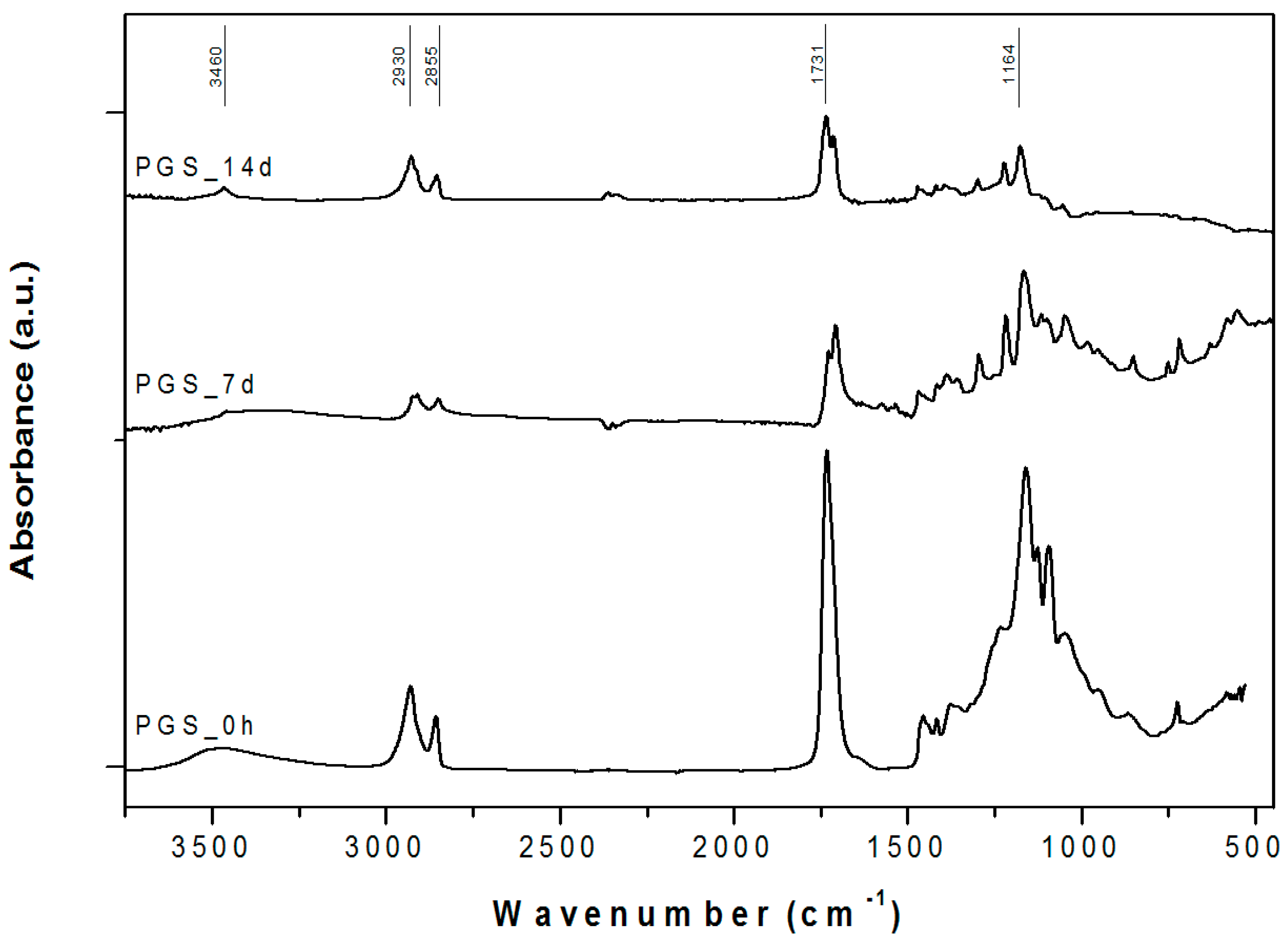

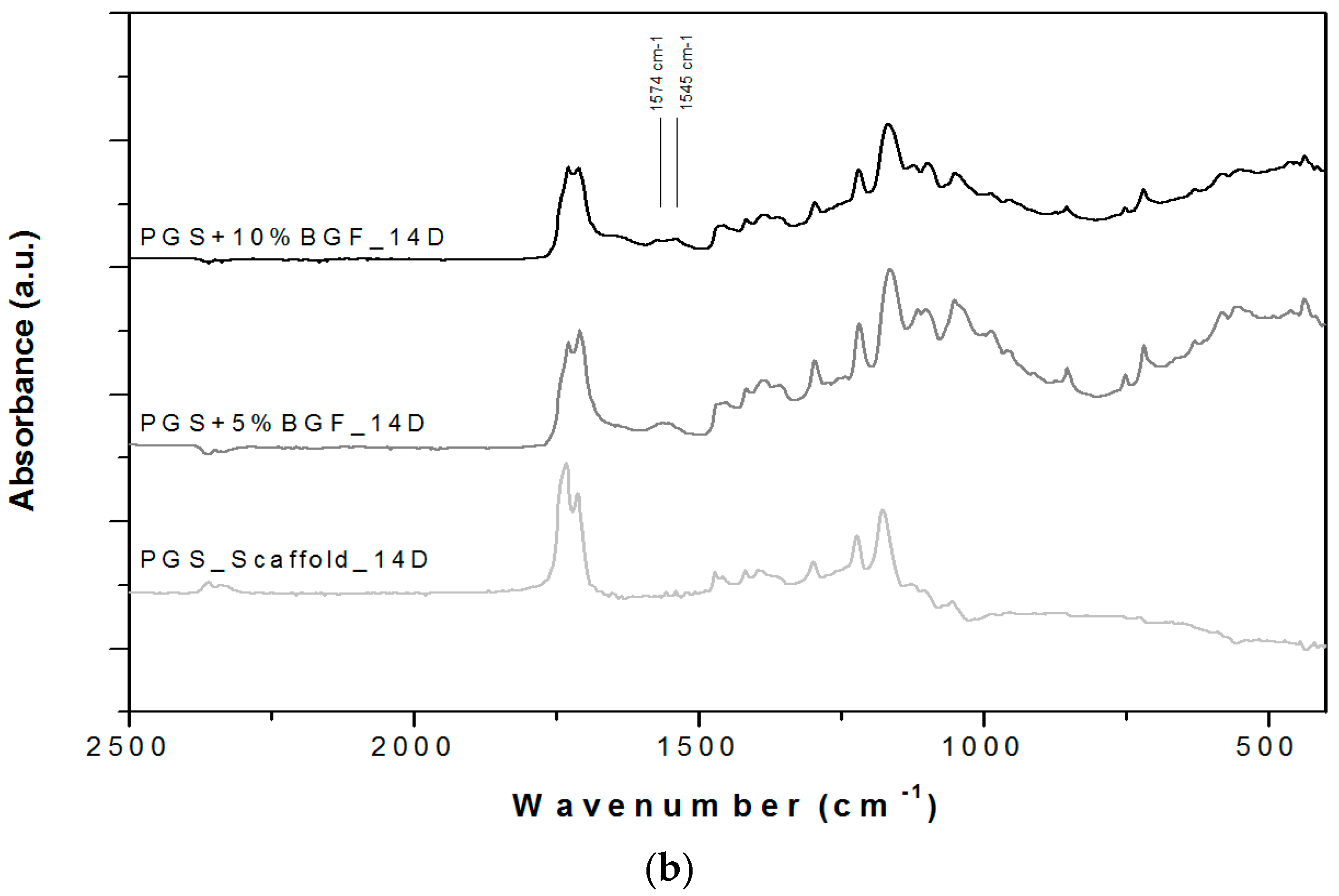
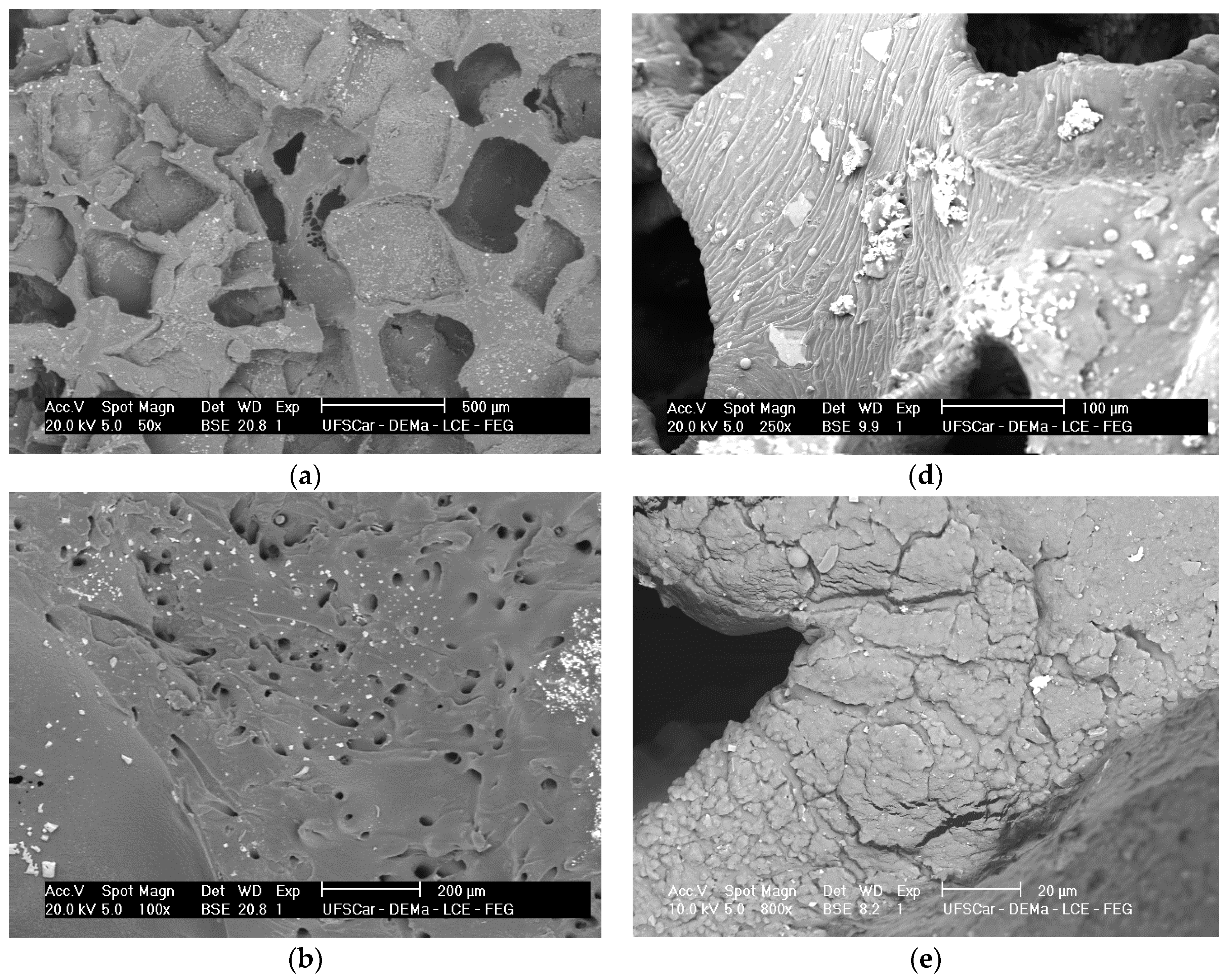
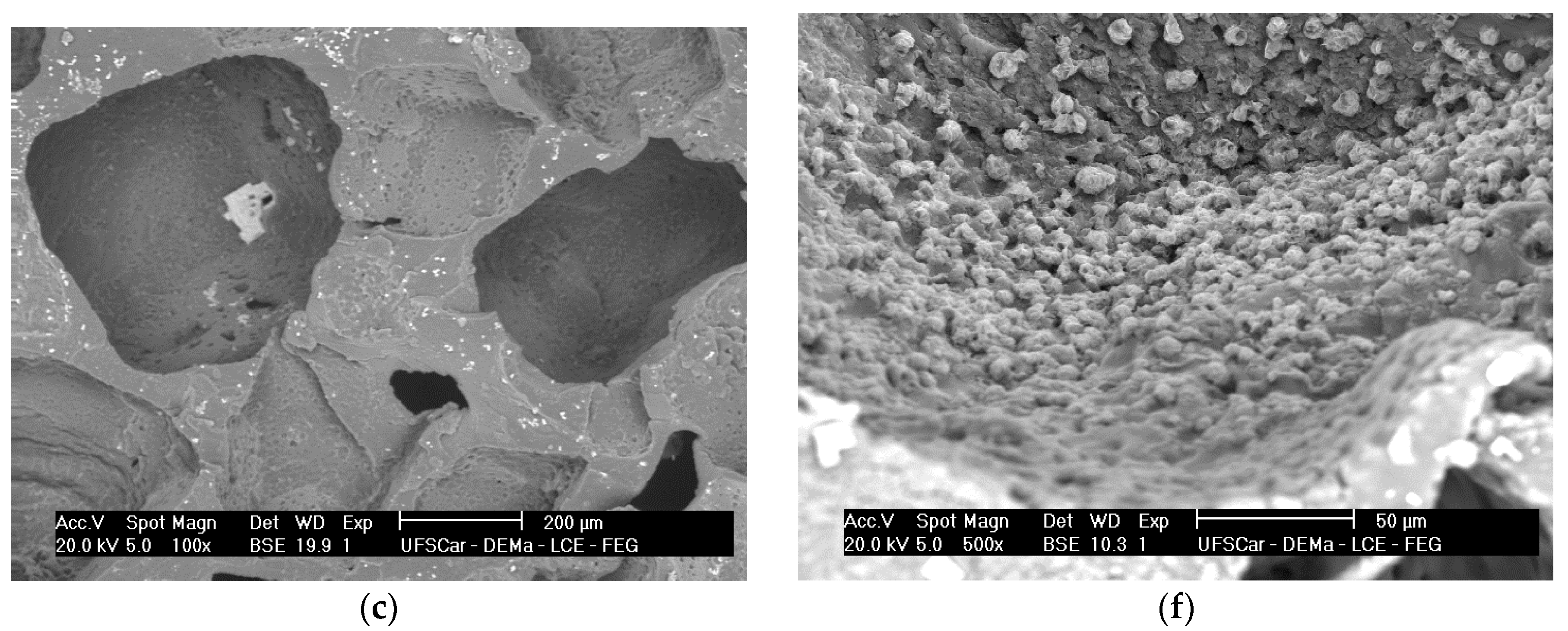
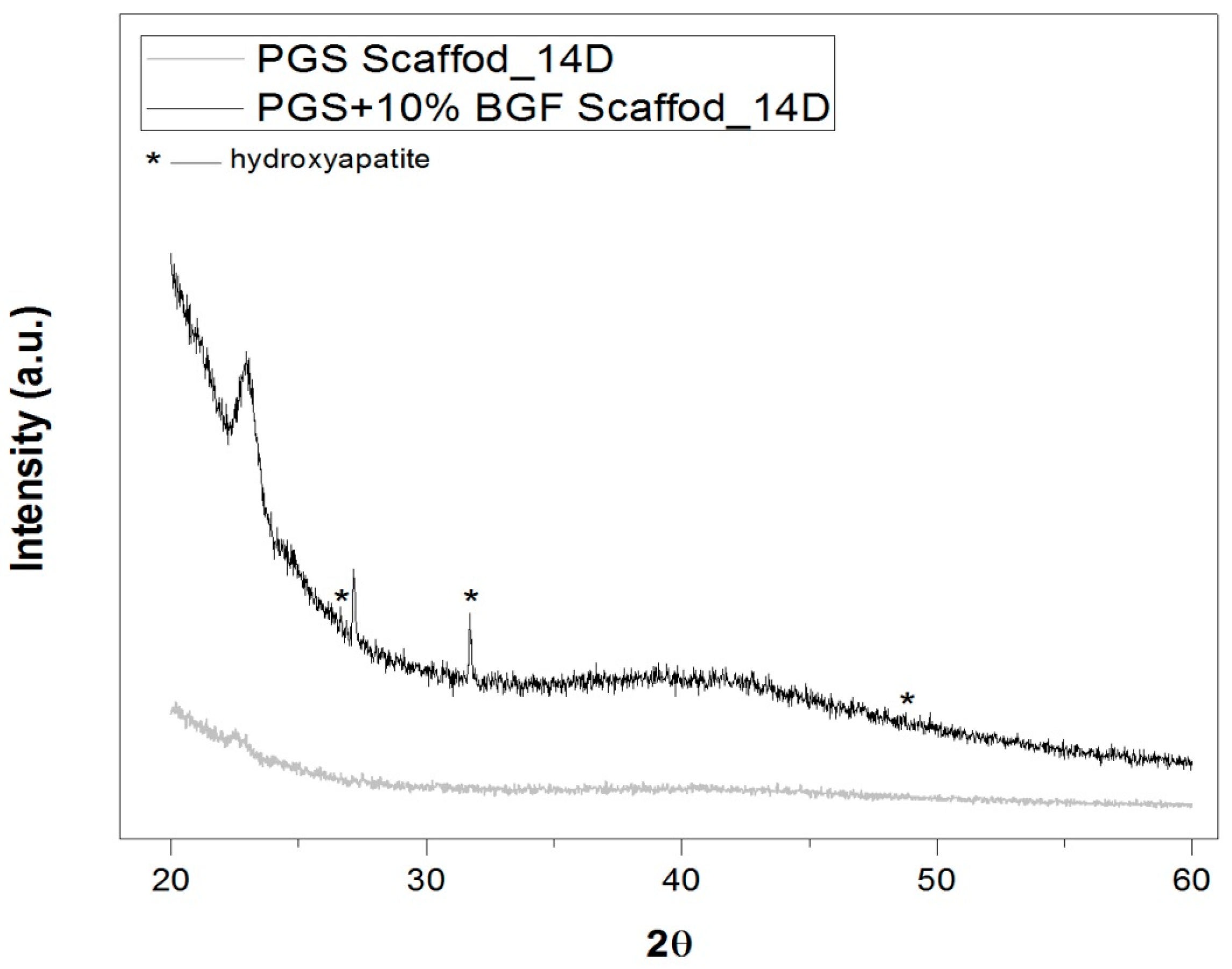
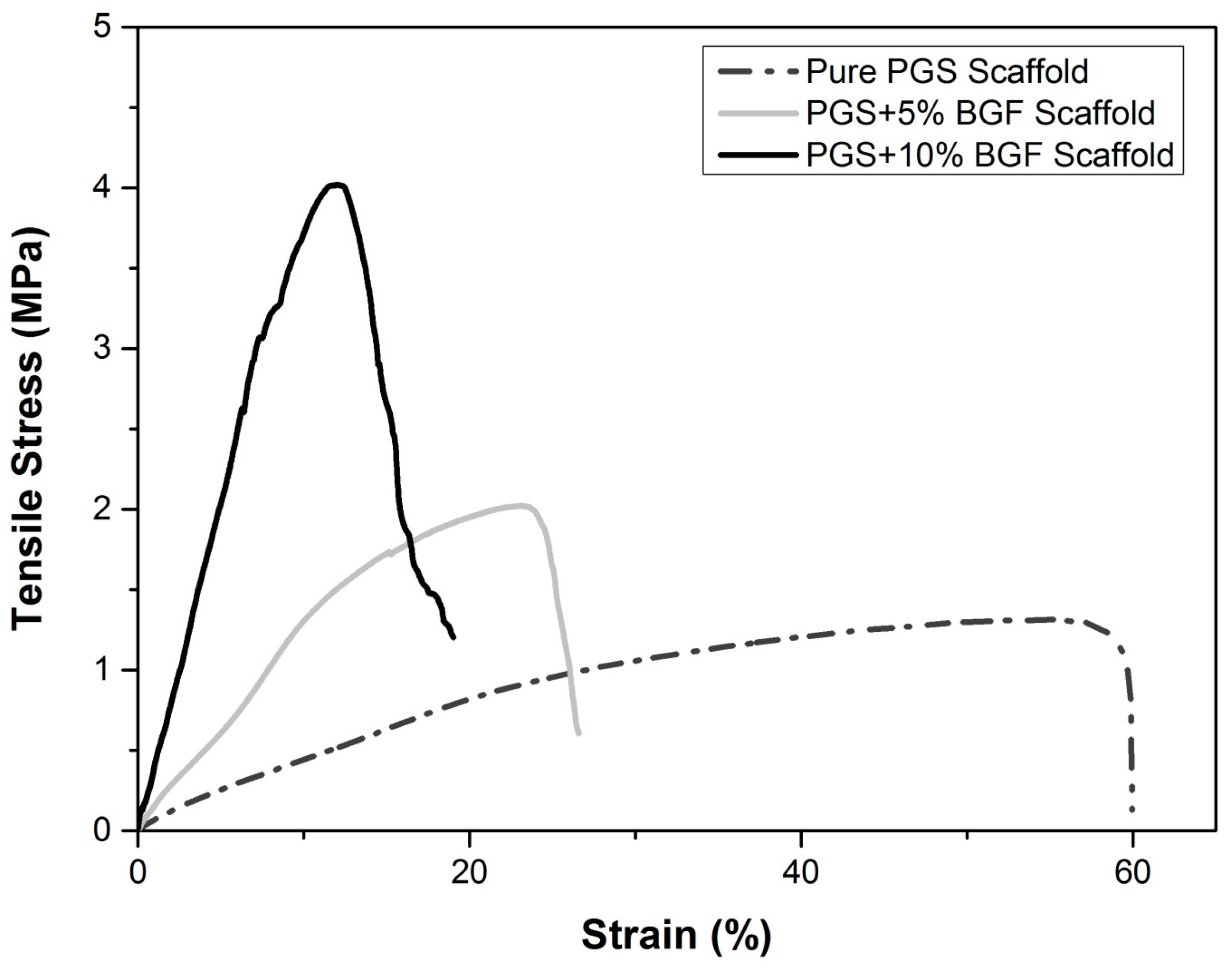
| Material | Mean Strain (%) | Mean Tensile Strength (MPa) |
|---|---|---|
| Pure PGS Scaffold | 75 ± 14 | 1.2 ± 0.2 |
| PGS + 5% BG Fibers Scaffold | 32 ± 10 | 1.8 ± 0.5 |
| PGS + 10% BG Fibers Scaffold | 30 ± 10 | 2.5± 0.8 |
© 2017 by the authors. Licensee MDPI, Basel, Switzerland. This article is an open access article distributed under the terms and conditions of the Creative Commons Attribution (CC BY) license ( http://creativecommons.org/licenses/by/4.0/).
Share and Cite
Souza, M.T.; Tansaz, S.; Zanotto, E.D.; Boccaccini, A.R. Bioactive Glass Fiber-Reinforced PGS Matrix Composites for Cartilage Regeneration. Materials 2017, 10, 83. https://doi.org/10.3390/ma10010083
Souza MT, Tansaz S, Zanotto ED, Boccaccini AR. Bioactive Glass Fiber-Reinforced PGS Matrix Composites for Cartilage Regeneration. Materials. 2017; 10(1):83. https://doi.org/10.3390/ma10010083
Chicago/Turabian StyleSouza, Marina Trevelin, Samira Tansaz, Edgar Dutra Zanotto, and Aldo R. Boccaccini. 2017. "Bioactive Glass Fiber-Reinforced PGS Matrix Composites for Cartilage Regeneration" Materials 10, no. 1: 83. https://doi.org/10.3390/ma10010083





